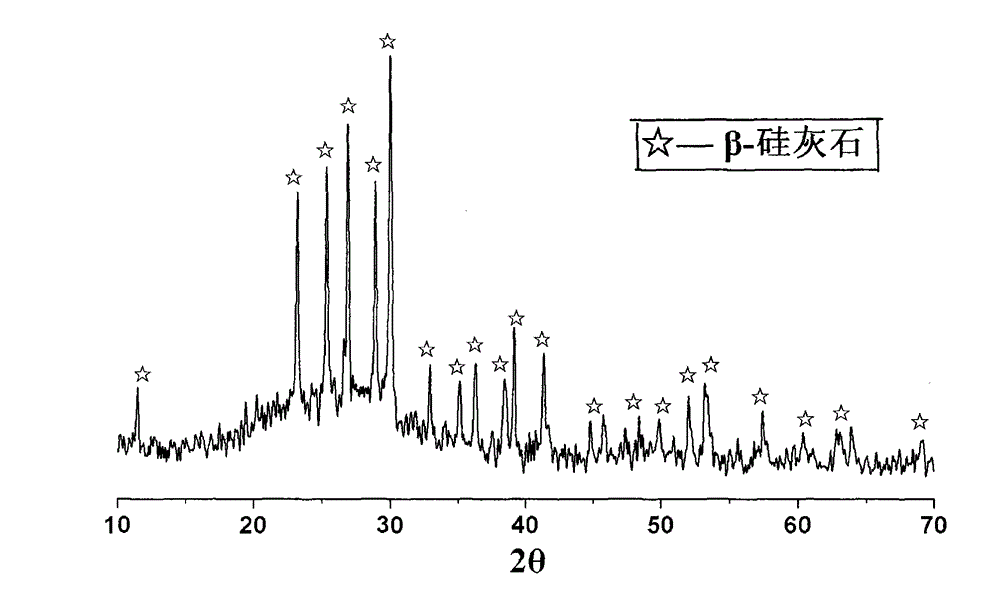Thin-type CaO-Al2O3-SiO2 system glass ceramics and preparation
A technique of cao-al2o3-sio2 and glass-ceramics, applied in the field of glass, can solve the problems of large weight per unit area, large consumption of raw materials, and high energy consumption, and achieve the effects of enhanced adaptability, improved product quality, and guaranteed quality
- Summary
- Abstract
- Description
- Claims
- Application Information
AI Technical Summary
Problems solved by technology
Method used
Image
Examples
Embodiment 1
[0019] Embodiment 1. Preparation of glass-ceramic:
[0020] Ingredients (mass percentage): Quartz sand 52.4%, alumina 4.9%, calcium carbonate 24.7%, zinc oxide 1.7%, barium carbonate 4.2%, sodium carbonate 7.7%, potassium carbonate 1.8%, borax 2.3%, antimony trioxide 0.4% ingredients. This formula is characterized by using K 2 O to partially replace ZnO, K 2 O not only reduces the viscosity of the glass, but the surface tension of the glass increases with K 2 The increase of O instead of ZnO content decreases, which is beneficial to the discharge of bubbles and the flattening of the surface during sintering.
[0021] Preparation of glass-ceramics: Mix the weighed raw materials to prepare a glass batch. The batch material is melted and clarified at 1450±10°C, and the melted glass liquid is water-quenched into 0.5-6mm glass particles, and then dried and classified. Spread the dry glass granules on the refractory mold, the particle size of the upper layer is 2-3mm, and the t...
Embodiment 2
[0023] Embodiment 2. Preparation of glass-ceramic:
[0024] Ingredients (mass percentage): Quartz sand 51.6%, alumina 4.2%, calcium carbonate 25.2%, zinc oxide 1.7%, barium carbonate 4.3%, sodium carbonate 7.9%, magnesium oxide 2.5%, borax 2.3%, antimony trioxide 0.4% ingredients. The feature of this formula is that ZnO is partially replaced by MgO. The introduction of MgO can promote the precipitation of wollastonite crystal phase in the glass, and can enhance the compactness and mechanical strength of the glass.
[0025] Preparation of glass-ceramics: Mix the weighed raw materials to prepare a glass batch. The batch material is melted and clarified at 1450±10°C, and the melted glass liquid is water-quenched into 0.5-6mm glass particles, and then dried and classified. Spread the dry glass granules on the refractory mold, the particle size of the upper layer is 2-3mm, and the thickness of the paving is 20mm. After paving and scraping, place it in a high-temperature experime...
Embodiment 3
[0027] Embodiment 3. Preparation of glass-ceramic:
[0028] Ingredients (mass percentage): Quartz sand 51.3%, alumina 4.1%, calcium carbonate 25.1%, zinc oxide 0.4%, barium carbonate 4.3%, sodium carbonate 7.8%, potassium carbonate 1.8%, magnesium oxide 2.5%, borax 2.3% , Antimony trioxide 0.4% ingredients. This formulation is characterized by the use of MgO and K 2 O is mixed and introduced to replace ZnO, so that the content of ZnO is further reduced and the cost of raw materials is saved.
[0029]Preparation of glass-ceramics: Mix the weighed raw materials to prepare a glass batch. The batch material is melted and clarified at 1450±10°C, and the melted glass liquid is water-quenched into 0.5-6mm glass particles, and then dried and classified. Spread the dry glass granules on the refractory mold, the particle size of the upper layer is 2-3mm, and the thickness of the paving is 20mm. After paving and scraping, place it in a high-temperature experimental furnace for crysta...
PUM
| Property | Measurement | Unit |
|---|---|---|
| thickness | aaaaa | aaaaa |
| thickness | aaaaa | aaaaa |
| thickness | aaaaa | aaaaa |
Abstract
Description
Claims
Application Information
 Login to View More
Login to View More - R&D
- Intellectual Property
- Life Sciences
- Materials
- Tech Scout
- Unparalleled Data Quality
- Higher Quality Content
- 60% Fewer Hallucinations
Browse by: Latest US Patents, China's latest patents, Technical Efficacy Thesaurus, Application Domain, Technology Topic, Popular Technical Reports.
© 2025 PatSnap. All rights reserved.Legal|Privacy policy|Modern Slavery Act Transparency Statement|Sitemap|About US| Contact US: help@patsnap.com

